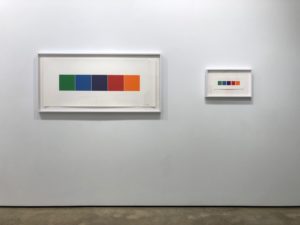Ellsworth Kelly – Prints
Lora Reynolds Gallery
February 9 – April 7, 2018

Color Squares 3
AX 335
Color Squares 4
AX 337
Lora Reynolds presents Ellsworth Kelly: Prints, an exhibition of lithographs made between 1966 and 2012.
Starting in the 1940s, Ellsworth Kelly made paintings, sculptures, and prints of precise, simplified shapes in vibrant color—alone or in concert with others—and contour drawings in pencil or lithographic crayon of plants, flowers, and fruit. Shape and color are the primary subjects of his art, but his work stands apart from that of other early geometric abstractionists—which was characterized by a preoccupation with math and conceptualism—in that it was always derived from visual experiences Kelly chanced upon in the world. He made sketches and photographs—of the gentle curve of a snowy hill, shadows falling on a staircase, reflections in water, or the negative space under a bridge—which he would later return to, study, and transform into artworks with unidentifiable origins.
Many of Kelly’s shapes are unfamiliar, bulging polygons: quadrilaterals with no parallel sides, fragments of a circle that include an arc but no radii, skewed squares, and all manner of other geometric exotica. Sidney Felsen, the founder of Gemini G.E.L., once said, “Kelly can just make a shape better than anyone else.” Perhaps this is because he did not invent them; he found his shapes in the world. The art historian Richard Shiff described a flattened paper cone—a blue and white container that once held an icy treat—that captured Kelly’s attention in the 1950s when he found it in a street gutter. The artist picked it up, brought it to his studio, and went back to it again and again for inspiration over the course of half a century. Blue Curve, 1988, a large lithograph in this exhibition, is distantly connected to this fabled cup that Kelly lifted from detritus.
“I’ve always been a colorist, I think. I started when I was very young, being a bird-watcher, fascinated by the colors of birds,” Kelly once mused. His smooth, flat fields of assertive color have been repeatedly described as hedonistic, but there are no archetypal Kelly colors; their range is actually quite subtle and complex. Reds may be bluish or yellowish; yellows are variably greenish or orangey. Kelly considered each artwork individually, searching for the perfect color to pair with a given shape; he sought to form an effortless, inseparable unit wherein neither element overpowered the other. Kelly did say, however, “I like color in its strongest sense. I don’t like mixed colors so much, like plum or deep, deep colors that are hard to define. I like red, yellow, blue, black, and white—that was what I started with.”
One of Kelly’s lifelong projects—his Spectrums—began as a student assignment to reproduce the Munsell color chart by hand. Munsell’s system is an extensive color space organized by hue (e.g., red or blue), value (lightness/darkness), and chroma (intensity). Kelly never lost interest in trying to reduce Munsell’s hundreds of data points into just a handful of colors that were perfectly coordinated in value and chroma. It was very difficult to do, Kelly said, because “each color has to be the right red, the right purple,” and the transitions between each pair had to be seamless and balanced. Making a violet as brilliant as a yellow—and conversely, a yellow as weighty as a violet—was no easy task. He chose the colors for his Spectrums intuitively, in a celebration of light (which Isaac Newton proved was comprised of many colors) and seeing.
But the artworks that make the connection between visual perception and Kelly’s fascination with shape incontrovertible are his plant drawings. Simple and elegant, they capture only the outline of a Calla lily, vine of grape leaves, or pear—and with few exceptions, never include any color, shading, or dimensionality. Each drawing is of a single plant form—never a bouquet of multiple species—that dominates the page while being surrounded by negative space, isolated from all context. Kelly’s clean, confident line in these drawings emphasizes the shapes in flora—in nature—that attract his eye, pointing to the otherwise mysterious origins of his colorful and sensuous prints, sculptures, and paintings.
Considering the untraceability of the majority of Kelly’s work and that all of it is inspired by his specific observations of everyday life, unknowability becomes an important conceptual anchor that remained constant for the entirety of his career. He spent his life distilling fleeting, mundane moments of visual intrigue into artworks that take the viewer beyond their normal experience of the world. As curator Richard Axsom put it, “…[Kelly’s] paintings, sculptures, and prints are physical objects and a part of our sphere. His serene art, then…is a conduit between two realms: the phenomenal and the transcendental.”
[More Information]